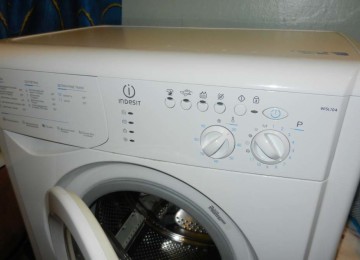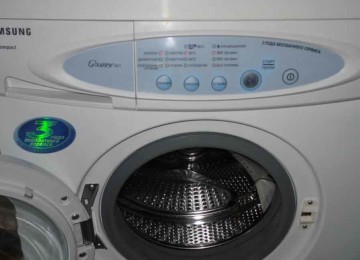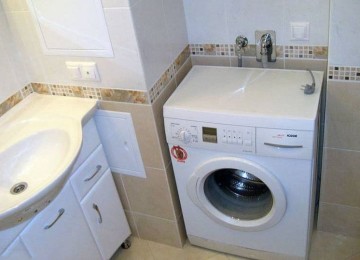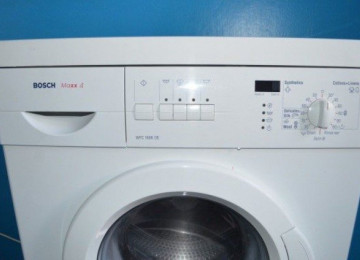Modern washing machines sold in hardware stores and shopping centers are divided into two categories. These are devices in which laundry is loaded from the top or front side. Considering the presented assortment, many questions arise: what is a front-loading washing machine, what is the difference between such models and their vertical counterparts, and which device is better to choose? We will answer these and many other questions in detail.
Differences between frontal and vertical washing machines
The main difference between a front washing unit and a vertical device is the method of loading laundry. In the first case it is loaded from the front, in the second - from the top. The design of the vertical machine provides for the presence of special doors located in the upper part of the machine. They are equipped with a mechanical lock.The loading tank in a vertical machine is attached to two symmetrical shafts, while the tank in a frontal machine is attached to one shaft located at the rear of the device.
The loading and unloading process in vertical machines occurs in two stages. At the first stage, the external hatch opens, at the second - the drum. In some models, before opening, you have to rotate the drum so that the flaps are opposite the hatch.
Modern units are equipped with a special system that facilitates the procedure of unloading laundry and ensures that the drum stops in a convenient position.
In a front-type machine, the drum is located on the front side of the equipment. It is attached in such a way that the entire washing process can be seen through the glass door. The glass from which the hatch is made has ultra-strong characteristics. It is hermetically sealed, so no leaks should occur. When washing, the door is automatically locked; it can only be opened at the end of the process, when there is no water in the tank.
As a rule, the dimensions of the hatch of a front-facing machine are an order of magnitude larger than the size of the doors of a vertical unit. This allows you to load bulky items into the tank. Another design difference in both types of devices is the location of the control panel.
Features of front-loading washing machines
Today, models of frontal units are produced, the hatch diameter of which varies from 23 to 33 cm. The size of the drum can also vary. All these characteristics are indicated in the technical description, so every buyer will be able to choose a device to suit every taste.For example, the comfort during operation of the unit and the volume of items washed in one cycle depend on the size of the drum. Ease of use also depends on the opening angle of the door. In the newest models, the hatch opens 180 degrees.
A tight fit of the sash to the body in the closed position is ensured by a rubber seal. It is present around the entire circumference of the hatch and prevents water leakage. The rubber cuff is resistant to the aggressive effects of powders; it does not lose its qualities even after many years of intensive use of the machine.
The machine is controlled through automatic programs. To select the desired parameters, there are buttons or a touch screen; all settings are reflected on the digital display. The user can select the desired program or independently set the washing parameters: temperature and spin.
Due to the fact that the control panel in front devices is located on the front part, the upper horizontal surface can be used as additional storage space for some things.
For example, baskets for linen, powders and hygiene products. In vertical devices, the top cover must be free to provide access to the drum if necessary.
The modern user appreciates the benefits of using built-in front models. Such equipment can be easily installed under the sink, in a kitchen unit, or any other place away from view. Thanks to these devices, the kitchen or bathroom space turns into a cozy corner with impeccable design.
Advantages and disadvantages of front-facing washing machines
The advantages of horizontal loading washing machines include:
- Possibility of integrating equipment into furniture. In this case, the equipment is securely attached to the furniture frame, therefore the level of vibration during operation of the unit is significantly reduced. Reducing vibration helps to increase the service life of the machine, and the operation of the built-in device becomes almost silent.
- Use the surface as additional storage space. If the equipment is mounted as a free-standing household appliance, its surface can be used to store various accessories: powders, capsules, filters, hair dryer and laundry basket. It is undesirable to place fragile objects on it, as they may fall under the influence of vibration.
- Possibility of installation in small apartments. If there is not enough free space, the machine can be mounted under a countertop, sink or some other furniture attribute. In this case, it is better to choose a narrow model, the depth of which is 45 cm. This arrangement will save free space, and it will still be convenient to use all the functions.
- Observe the washing process through a glass window. If necessary, washing can be stopped in a timely manner. This is necessary when there are keys, a phone or other items in your clothing pockets that are perfectly visible through the transparent door.
- Large capacity. Devices with horizontal loading have a larger capacity and a wider opening. You can send bulky items, down jackets, pillows, and blankets for washing.
- Relatively low cost. Front-loading devices are lower than similar top-loading devices. And the cost of repairs is significantly lower.
- Wide selection of products.There are a variety of frontal units available on the market, so the buyer will be able to choose the right device depending on price, brand, quality, weight and even design.
The disadvantages of front devices include the fact that additional space is required to open the hatch. This is why in small rooms problems may arise when installing equipment. When loading or unloading things, you will have to bend over, which is not very convenient for older people or those who suffer from back pain.
Dimensions of front washing equipment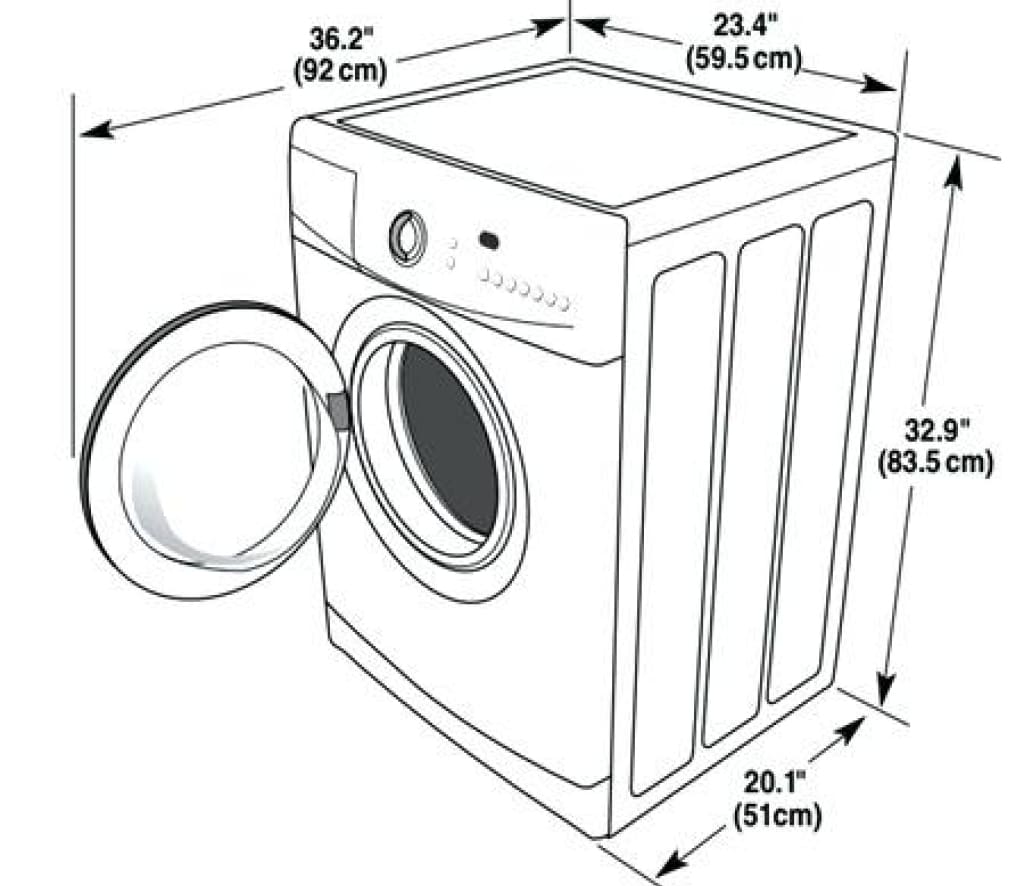
Most buyers pay great attention to the dimensions of the washing machine. This is justified, since the slightest error will lead to the fact that the device will not fit in the space allocated for installation. It is extremely important before purchasing equipment to take correct measurements of the space and, depending on these values, select a device of suitable dimensions. A machine installed incorrectly, on a slope, will not work satisfactorily, and its service life will be significantly reduced.
Front washing machines are available in various sizes. There are full-size models, the height of which ranges from 85-90 cm, width and depth - 60 cm. The depth of narrow models is about 35-45 cm. There are also ultra-narrow specimens, the depth of which varies from 32 to 35 cm.
To save space in small rooms, models are designed whose height does not exceed 70 cm. They are installed under sinks, some models are already equipped with these accessories. The width of such products is in the range of 47-50 cm, depth - 43-45 cm.
When choosing a location for installing front-facing appliances, you should take into account that additional space will be required to conveniently open the door. That is why about 50-60 cm should be added to the depth parameter of the product.
Loading volume of front machine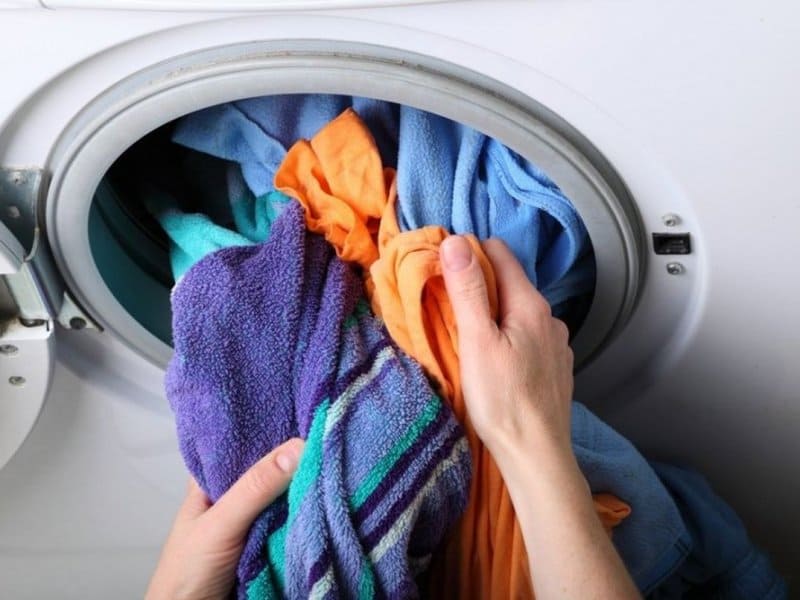
When choosing the optimal capacity of a washing machine, you should take into account your own household needs. For one person or a family of two people, a unit for 5 kg of laundry is quite suitable. It will ensure proper cleaning of the usual volumes of washing; the drum of the full-size model can easily accommodate a set of bed linen, a bedspread or outerwear. For a family with children, the volume of the machine should be larger; in this case, it is rational to purchase a device for 6-8 kg. For large families consisting of six or more people, washing machines with a capacity of at least 9 kg are suitable.
When purchasing a compact narrow model, you need to remember that large things will not fit into a small drum. It can only be used for washing clothes, other small household items and fabric accessories. Large textile accessories and bulky clothes will not fit in such a drum. At the same time, washing a small volume of items in a full-size model is considered irrational, since resources are spent uneconomically.
In addition to the maximum permissible volume of loaded laundry, you should pay attention to another parameter - the minimum permissible. It is 1 kilogram. If the drum is not loaded enough, things in it are distributed unevenly. This, in turn, leads to unbalanced operation of the unit, excessive vibration, load on structural components and rapid wear of parts.
It is also not recommended to overload the drum, as the quality of washing leaves much to be desired. It is recommended to fill the drum approximately two-thirds full.
Spin, wash, energy efficiency class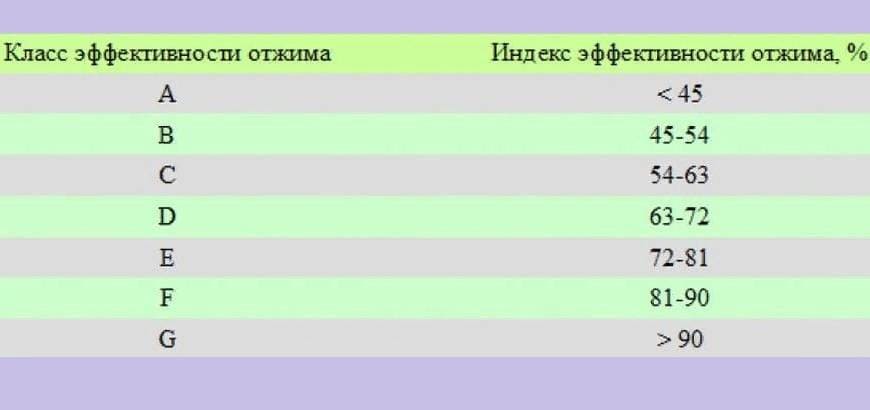
The markings on the body of the washing machine will help you select a product according to your own needs and evaluate the technical characteristics of the purchased device. These letter designations reflect the quality of the washing and spinning process, as well as the possibility of saving energy resources. The washing class is designated by the letters A, B, C, D, E, F, G: a product of class A has the best characteristics, G has the worst characteristics.
Modern models are marked with the symbols A, A+, A++. This is due to the fact that improved machines wash fabric better than the models adopted as the standard back in 1995. They provide gentle and high-quality stain removal. Models below class B are practically never found on the market, although it is almost impossible to determine by eye the difference between the results of washing a class A and class B machine.
Spin grade reflects the amount of residual liquid that is present in the fabric after removal from the drum. In class A machines this figure is in the range of 40-45%, in class C machines it is about 60%, which slightly increases the time required to dry clothes. Class A requires the use of a spin speed of 1600 rpm. It should be noted that for delicate fabrics such an aggressive effect can be disastrous, so for domestic needs models of class B (with a speed of 1200) and class C (1000 revolutions per minute) are quite suitable.
According to the regulations, energy consumption class A includes models that consume 0.17 kW per hour to wash one kilogram of laundry when the water is heated to 60 degrees. Class A+ includes washing machines that consume less than 0.15 kW under the same washing conditions. Modern models belong to class A, A+ and higher.
Standard set of programs for front washing equipment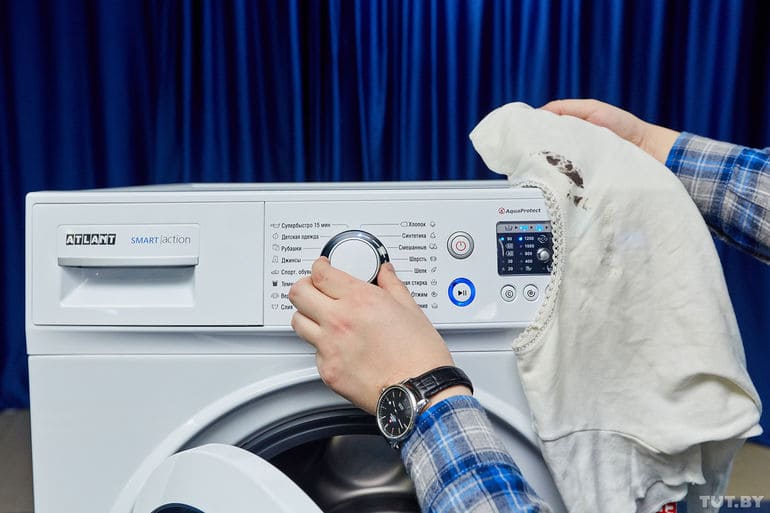
Almost all modern washing machines have programs for washing items made of cotton, synthetics, and wool. There is also a function for washing baby clothes and a delicate mode. In all cases, the machine automatically switches on the washing parameters, rinse time and spin speed. Additional washing programs include the following:
- Quick wash. Lasts about 15-30 minutes, allows you to refresh uncontaminated laundry. Not suitable for cleaning dirty items or removing stains.
- Economical washing. Provides for the use of cool water, resulting in significant energy savings. The consumption of water and detergents is reduced, but the cycle time increases.
- Soak. Suitable for heavily soiled items. Before washing, the laundry is immersed in water for 1-2 hours, its temperature does not exceed 30 degrees.
- Handwash. It is advisable to use for things that require careful care. Washing is carried out at an increased flow of warm water without spinning or with a reduced intensity of drum movement.
- Easy ironing. The program provides a special algorithm for the movement of the drum, which creates a minimum of folds. The washing time and the volume of water used also increases.
The number of programs used in different models differs; you can familiarize yourself with the full set of programmed modes in the instructions for the device.
Pros and cons of vertical washing units
The undeniable advantages of these models include:
- Installation in conditions of limited free space. The equipment is quite compact and does not require additional space for opening and closing the front hatch, so it can be installed even in small apartments.
- Possibility of reloading things. If the washing process has already begun, and you find an item that was not put into the drum, you can do this without any problems.
- There is no need to bend over to load or unload laundry.
- Safe operation. Due to the location of the panel on a horizontal surface, it is difficult for children to reach it.
The disadvantages of such models include a smaller loading volume compared to front-facing models and a small set of additional functions. Also, such devices cannot be built into a kitchen unit or under a sink.
Which machine is more convenient to use: vertical or frontal?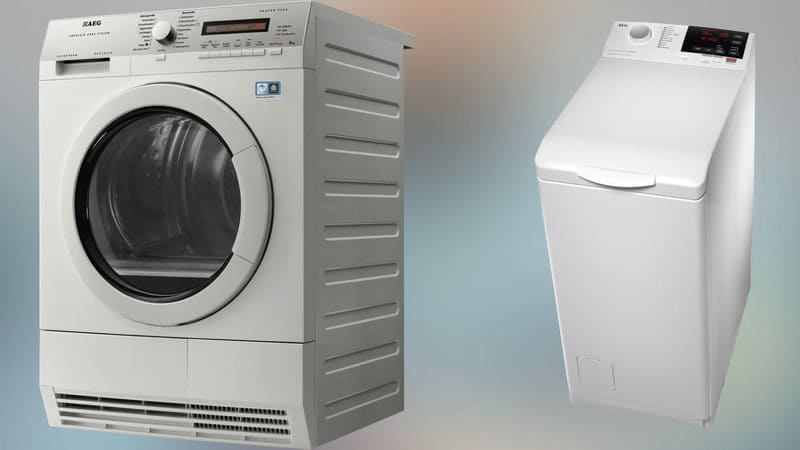
Ease of use of equipment is a subjective question, as it depends on the personal preferences of the owner. Still, there are some features of using vertical or horizontal loading washing machines. One of the criteria is the location of the powder receiver. The cuvette in vertical models is usually located under the lid, which is not always convenient. This is why difficulties may arise at first. The powder container in front models is located on the front of the device; it can be removed and washed without any problems.If you plan to install a washing machine in the kitchen, then you can adapt and use the upper part of such machines as an additional work surface.
Smooth operation is also an indicator of the ease of use of the machine. Experts say that vertical units break more often. Breakdowns occur due to the design features of the equipment - the unit components are located closer to each other, so they are most susceptible to the negative effects of vibration. Such equipment needs to be repaired more often, and its repair is more expensive.
Which washing machine is better to choose: front-loading or top-loading?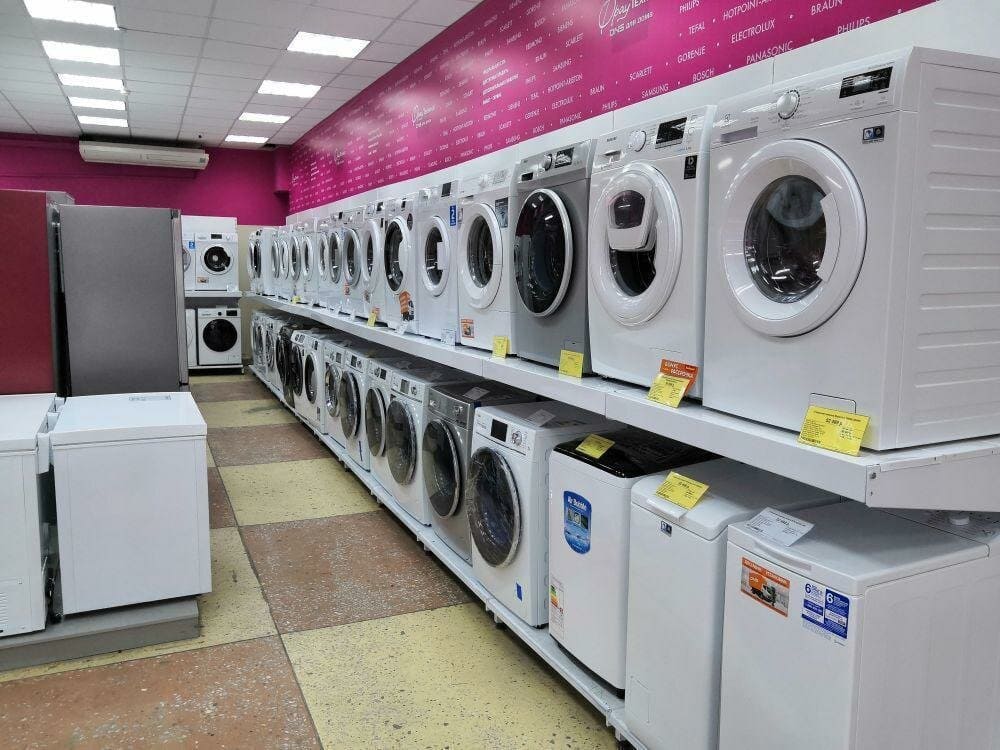
Before purchasing household appliances, you should understand how one type of washing machine differs from another. The operating principle of these devices is the same: after loading laundry into the drum, water and detergents are supplied to it. Depending on the selected program, the water temperature, wash duration and number of rinses are automatically selected. At the end of the wash cycle, the drum rotates at high speed, water is removed from the tank.
The dimensions of full-size frontal machines are quite impressive, so they cannot be installed everywhere. Experts recommend purchasing vertical machines for small spaces. They will fit perfectly into a non-functional corner space and take up a minimum of free space. Front washing machines are more popular; they have greater functionality and provide high-quality cleaning of bulky items. In addition, such devices are easy to integrate into furniture.
Having considered all aspects and analyzed the pros and cons of vertical and frontal devices, you can choose a device that meets your household needs.A properly selected machine will last a long time and become a real helper in the household.






